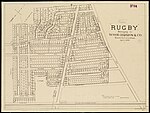Mattapan station
1929 establishments in MassachusettsFormer Old Colony Railroad stationsMattapan, BostonRailway stations in BostonRailway stations in the United States opened in 1929 ... and 1 more
Red Line (MBTA) stations

Mattapan station is an MBTA light rail station in Boston, Massachusetts. It is the southern terminus of the Ashmont–Mattapan High-Speed Line, part of the Red Line, and is also an important MBTA bus transfer station, with eight routes terminating there. It is located at Mattapan Square in the Mattapan neighborhood. At the station, streetcars use a balloon loop to reverse direction back to Ashmont station. Mattapan station is fully accessible, with mini-high platforms.
Excerpt from the Wikipedia article Mattapan station (License: CC BY-SA 3.0, Authors, Images).Mattapan station
Mattapan North Busway, Boston Mattapan
Geographical coordinates (GPS) Address Nearby Places Show on map
Geographical coordinates (GPS)
| Latitude | Longitude |
|---|---|
| N 42.2675 ° | E -71.093055555556 ° |
Address
Mattapan Trolley - Exit Only
Mattapan North Busway
02126 Boston, Mattapan
Massachusetts, United States
Open on Google Maps








